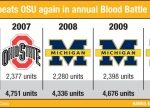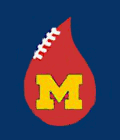Erin Ferris is a lifelong Red Crosser and our newest blog contributor.
Every Red Cross chapter, in accordance with the organization’s mission, “provides relief to victims of disaster and helps people prevent, prepare for, and respond to emergencies”. But many Red Cross chapters also coordinate unique programs, fundraisers, and outreach efforts that support the larger Red Cross mission.
One of my favorite Red Cross programs – Blood Battle – kicks off this week, and its arrival got me thinking about how I’d like to share some of these programs with you via this blog.
So without further adieu, please enjoy my first “Spotlight On…” post!
 Blood Battle, now in its 30th year, is a blood collection competition between the University of Michigan in Ann Arbor and Ohio State University in Columbus. Each year, during the two weeks leading up to the UM vs. OSU football game, students, faculty, staff, and community members donate blood at campus blood drives in an effort to help their school collect more pints of blood than are collected at the opposing school.
Blood Battle, now in its 30th year, is a blood collection competition between the University of Michigan in Ann Arbor and Ohio State University in Columbus. Each year, during the two weeks leading up to the UM vs. OSU football game, students, faculty, staff, and community members donate blood at campus blood drives in an effort to help their school collect more pints of blood than are collected at the opposing school.
The competition is fierce: in 2007, OSU won by a mere three pints (or three donors) – a very small margin considering each school collected more than 2,000 pints. Last year, UM came out on top after collecting 2,615 pints compared to OSU’s 2,515 pints; that means that in 2010, Blood Battle brought in 5,130 pints of blood and potentially saved 15,390 lives. Incredible.
I’ve chosen Blood Battle as the subject of my first “Spotlight” post not because of the competition, but because of the collaboration. As Mark Huizenga, Blood Services Volunteer Coordinator for the Washtenaw County American Red Cross in Ann Arbor, put it, “Everyone gets a kick out of beating the school down south, but the real goal is to save as many lives as possible, and the community achieves this through campus-wide collaboration.”
During my six years at the Washtenaw County American Red Cross I saw firsthand the unbelievable collaborations that made this event – at least on the UM side of the competition – possible and successful. (Note: I’m certain collaboration is a big part of OSU’s efforts as well, but for this post I’ve chosen to focus on the partnerships I’ve seen in action at UM.)
While sponsored by the American Red Cross, Blood Battle has always been the “baby” of Blood Drives United (BDU) – the mission of which is to provide blood donation opportunities on the UM campus and educate students, faculty, and staff about the importance of blood donation – and its larger organization, the UM service fraternity Alpha Phi Omega (APO).
In 2005, when an American Red Cross Club (RCC) was founded at UM, the leaders of BDU and the RCC recognized an overlap in their clubs’ goals and set out to combine forces and make Blood Battle – and blood collection on the UM campus – bigger and stronger than it had ever been before.
The initial stages of collaboration were difficult. Unintentionally, feathers were ruffled, toes were stepped on, and boundaries were crossed. In those first two years, there was very little actual collaboration going on, and it showed – UM was “out-collected” in 2005, 2006, and 2007. “Not everyone sees eye-to-eye on everything,” said Aparna Ghosh, RCC Vice President. “But when the goal is one – as it is with Blood Battle – and everyone is united toward that common goal, differences are more easily set aside.”
 By 2008, leaders from both clubs began to appreciate what the other group brought to table; BDU/APO brought history and experience and student connections, while the RCC brought new ideas, new blood (literally and figuratively), and name recognition. These contributions were slowly pieced together in a way that allowed everyone to be a part of Blood Battle’s success, and in 2008, 2009, and 2010, UM brought home the trophy. Said Kevin Weiss, one of the 2011 BDU Blood Battle Co-Chairs, “Blood Battle is a huge undertaking, and we are appreciative of any help we can get from other organizations such as the RCC. We feel that the more people we have involved, the greater the number of lives that can be saved.”
By 2008, leaders from both clubs began to appreciate what the other group brought to table; BDU/APO brought history and experience and student connections, while the RCC brought new ideas, new blood (literally and figuratively), and name recognition. These contributions were slowly pieced together in a way that allowed everyone to be a part of Blood Battle’s success, and in 2008, 2009, and 2010, UM brought home the trophy. Said Kevin Weiss, one of the 2011 BDU Blood Battle Co-Chairs, “Blood Battle is a huge undertaking, and we are appreciative of any help we can get from other organizations such as the RCC. We feel that the more people we have involved, the greater the number of lives that can be saved.”
Kevin’s right. The key reason to allow, seek out, and then nurture collaboration, at least with regard to Blood Battle, is that more people involved (more clubs involved = more students involved = wider campus/community reach) translates to MORE LIVES SAVED. The success and lives saved as a result of Blood Battle are examples of what can be accomplished when organizations are willing to welcome others to the table and focus on a common goal.
Said Claire Smith, one of the RCC Blood Services Committee Co-Chairs, “All of the hours of work will be 100% worth it when I see student organizations working together to save thousands of lives…Recipients get the blood they need, donors leave with instant gratification, and the RCC and BDU/APO recognize the influence of their collaboration in the community.”
I couldn’t have said it better myself. I will, however, add a little something…Go Blue!

